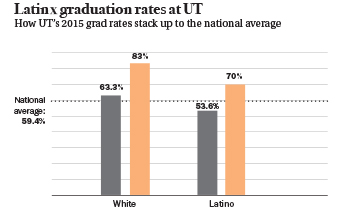More Latino students are enrolling at UT and U.S. universities, but they are still not graduating at the same rate as white students.
A December report by The Education Trust highlighted a 10-percent gap between the national graduation rates of Latinx and white students in 2015. The report also found a 13-percent gap at UT-Austin and similar gaps at other UT universities.
In 2015, 63.3 percent of white college students graduated from U.S. universities within six years, but only 53.6 percent of Latino students graduated, according to report author Andrew Nichols.
“If university leaders believe in the inherent potential for all students to succeed, regardless of race or ethnicity, then there is no way to justify that kind of gap,” Nichols said in an emailed statement.
The 2015 national Latinx graduation rate remains higher than that for black and Native American students, but the report states that this improvement is slow compared to the recent growth in Latinx enrollment.
Enrollment for Latinx students nearly tripled between 1999 and 2016, according to the Pew Research Center. At UT, the number of Hispanic students increased by a little over 20 percent between 2008 and 2013, said Carolyn Connerat, associate vice provost for Student Success Initiatives, which oversees UT’s student support programs.
The Education Trust found UT’s six-year graduation rate of 70 percent for Hispanic students to be higher than the national average, but lower than the calculated 83-percent rate for white UT students.
“Higher-performing institutions like UT Austin still can do more in terms of achieving equity,” Nichols said in an email.
Connerat said UT-Austin studies graduation rates by ethnicity as part of its overall goal to improve four-year graduation rates. Since 2013, UT has tried to increase four-year graduation rates for all students from 52 to 70 percent by implementing First-Year Interest Groups and success programs such as the Gateway Scholars Program.
“Many of our programs across campus are predominantly (Latinx),” Connerat said. “But there’s a focus on helping those students that are first-generation to be successful.”
Aerospace engineering junior Jose Guillen remembers feeling lost as a Latino first-generation student his freshman year. The Education Trust reported that Latinos are graduating at a lower rate than white students. Juan Figueroa | Daily Texan Staff
Aerospace engineering junior Jose Guillen, a Latino first-generation student, remembers feeling lost his freshman year and said he often couldn’t ask his parents for help.
“Coming to UT, it was surprising to see people who already knew what steps to take and had mentors in the (aerospace industry),” Guillen said.
Connerat said making sure Hispanic and Latinx students know about the resources available to them has been a big part of the University’s efforts.
The University reached a 65.7 percent overall four-year graduation rate in 2017, and Connerat said Hispanic students had showed some of the most significant increases. The four-year graduation rate for UT’s Hispanic students has increased from 43 percent to 60 percent since 2013, Connerat said.
Connerat said the impact of the initiatives put in place in 2013 are still not evident in 2017’s six-year graduation rates, but the six-year graduation rate for Hispanic students in 2017 was 74.5 percent.
With UT’s help, Guillen has managed to maneuver through UT and his industry, even securing an internship in France last summer, but said he wishes UT’s resources were more proactive.
“Although UT has all these specific references available, it would be good if they could compile them, so you know what to do from the start,” Guillen said.




















